Chapter 2 Continuity Of Life Reproduction Summary
WBBSE Class 10 Reproduction Overview
- Reproduction is an important event for the existence of living organisms. Reproduction is mainly of two types-asexual reproduction and sexual reproduction. Vegetative reproduction is a special type of asexual reproduction.
- The formation of new offspring from somatic cells without fertilization is called asexual reproduction and the formation of new offspring by fusion of gametes is called sexual reproduction.
- The formation of the new individual directly from the segment of parent body is called vegetative reproduction. Asexual reproduction is mediated by single-parent cells, whereas in sexual reproduction two parent cells need to participate.
Read and Learn More WBBSE Solutions for Class 10 Life Science And Environment
- In sexual reproduction, due to meiotic division, variation occurs in new offspring, so offspring with new characteristics will be produced.
- Asexual reproduction may be of various types like fission [Amoeba] budding [Hydra, Yeast], fragmentation [Spirogyra], regeneration [Planaria], and sporulation [Moss, fern]
- In vegetative reproduction, a part of the plant cell can produce new plantlets. It is of two types-natural and artificial. In the natural process, shoot, root, or leaf can give rise to new plantlets, whereas in the artificial process cutting, grafting or micropropagation can mediate the generation of new plantlets.
- The alternation of a haploid and a diploid generation in the life cycle of an organism is called the alternation of generations. It is most distinct in fern.
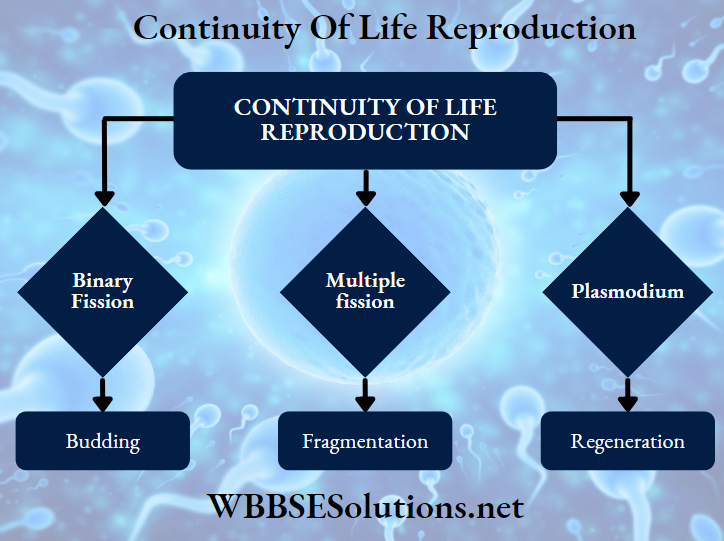
Chapter 2 Continuity Of Life Reproduction Long Answer Type Questions
Question 1. Mention the common features of reproduction. Mention the significance of reproduction. Or, Why reproduction is important for an organism?
Answer:
Common features of reproduction:
Different phases of reproduction involve mitosis, meiosis, or both the processes of cell division. From gametogenesis to the embryonic development of a progeny, cell division is required in every phase.
- The molecular basis of reproduction is DNA replication.
- An offspring is formed through the union of gametes, germination of spores, or division of vegetative cells.
Significance of reproduction:
The significance of reproduction is as follows.
1. Increasing population size:
By means of reproduction, new individuals are born. As a result, the number of individuals in a population increases and the race of a species is maintained.
2. Maintaining the flow of genes:
By reproduction, the genes of a species flow from one generation to the next maintaining the hereditary characteristics.
3. Maintaining ecological balance:
Natural or unnatural death of individuals reduces the population size of a species. By reproduction, this loss is replenished in nature. This process keeps the ratio of different species in an ecosystem constant and thus maintains the ecological balance.
Life Science Class 10 Wbbse
4. Variation:
By sexual reproduction, different genetic variations come into existence. These variations assist any species to adapt in its surroundings and finally help in the evolution of new species.

Question 2. Briefly describe the different types of reproduction.
Answer:
Types of reproduction:
Two types of reproduction are seen in the living world. These are-
- Asexual reproduction and
- Sexual reproduction.
1. Asexual reproduction:
The type of reproduction, in which the formation of gametes and their fertilization do not occur, instead, certain body cells or specialized cells, like spores, divide to form the progeny, is known as asexual reproduction.
In this process, only one parent is required. All parental characters are inherited by the offspring. All the offspring become, genotypically and phenotypically identical to their mother.
For example Bacteria, several protists like Amoeba, and some fungi like Mucor, Penicillium, etc. perform asexual reproduction.
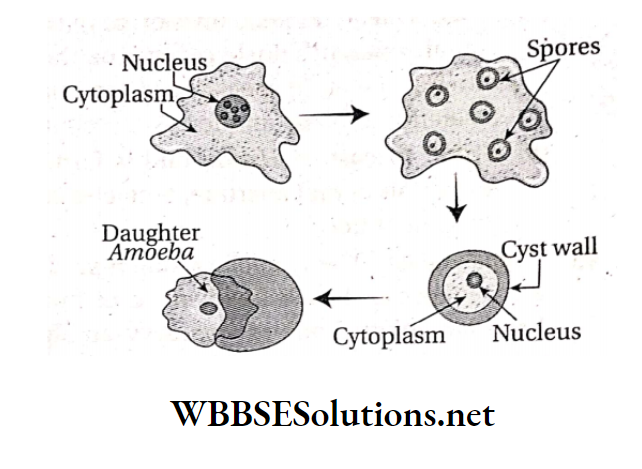
2. Sexual reproduction:
The type of reproduction, that involves the union of two different types of gametes to produce a zygote and the development of a new progeny from it, is known as sexual reproduction. Most of plants and animals perform sexual reproduction.
This process requires a male and a female member of the same species or a single organism with two different types of gametangia to produce male and female gametes. In this process, the union of male and female gametes takes place.
As a result, the progeny gets genotypic and phenotypic characteristics different from its parents. Sexual reproduction essentially requires meiotic cell division for gamete formation and for keeping the chromosome number of a species constant.
Example: Sexual reproduction occurs in all higher animals and plants such as frogs, men, birds, angiosperms, etc.
Life Science Class 10 Wbbse
Question 3. Describe the five processes of asexual reproduction with one suitable example for each.
Answer:
Processes of asexual reproduction:
The following types of asexual reproduction can be seen in organisms-
1. Fission:
In most of the unicellular organisms two or more offspring are produced through mitosis or amitosis. This process is called fission. Some example are given below.
1. Amoeba:
Binary fission:
In favourable conditions, the nucleus of Amoeba undergoes amitotic division and gives of two nuclei. Its cytoplasm divides longitudinally creating a furrow and forms two offsprings.
Multiple fission:
In unfavorable conditions, the pseudopodia of Amoeba are destroyed and the body gets encapsulated by a cyst wall. Inside the cyst, numerous small spores are formed through multiple fission of nucleus and cytoplasm.
This type of multiple fission is called sporulation. When the condition becomes favorable, spores come out rupturing the cyst wall and giving rise to new Amoeba offspring.
2. Plasmodium:
In the case of Plasmodium, multiple fission takes place in two stages-Schizont and sporont. In the stomach of female Anopheles mosquito, numerous Plasmodium offsprings are born by the multiple fission called schizogony and sporogony is the schizont and sporont stages respectively.
The Plasmodium offsprings born through schizogony and sporogony are called merozoite and sporozoite respectively.
2. Budding:
Budding is a type of asexual reproduction in which a new organism develops from an outgrowth or bud of the parent body due to cell division at one particular site. Some examples of budding are given below.
Yeast:
Due to the unequal division of the yeast parent cell, a small outgrowth or bud is formed which contains the parent’s nucleus. Later on the bud separates from the parental body and develops into new yeast.
In special cases, the bud of yeast divides many times in the torula stage through the Tormulation process and forms mycelium.
Hydra:
In the case of Hydra, the bud is formed outside the parent body (exogenous bud). After the formation of the oral aperture, tentacles, etc. when the offspring matures, it gets detached from the parent body.
3. Fragmentation:
The type of asexual reproduction where the parent body is fragmented into two or more pieces and each fragment turns into new offspring, is called fragmentation.
Example:
The filamentous body of Spirogyra, an alga gets fragmented due to water currents or external damage. Each fragment undergoes mitotic cell division and gives rise to new offspring.
4. Regeneration:
The type of asexual reproduction where a mere body part of a parent organism creates a new offspring, is called regeneration. It is also called morphallaxis.
Life Science Class 10 Wbbse
Example:
If any body part of Planaria, a flatworm gets detached, it forms a new offspring. This process also can be seen in Hydra.
5. Sporulation:
Sporulation is a type of asexual reproduction in which unicellular spores are produced in moss, fern and fungi, they are dispersed and give birth to new offspring. Examples of sporulation are given below.
Fungi:
In fungi, spores with different structure and with or without motility can be seen. These spores germinate in favourable conditions and new fungi are born. Different types of spores are motile zoospores, non-motile aplanospores, thick-walled chlamydospores, oidia, and conidia formed from fragments of filaments, sporangiospores formed in sporangium.
Moss and Fern:
Spores are formed from the sporophytic tissue of the sporophytic plant body of moss. In the sporangium of sporophytic plant body of fern, spores with similar or different shapes are formed.
Types of Reproduction in Living Organisms
Question 4. Describe the mechanism of fission in Plasmodium with a diagram.
Answer:
Mechanism of fission in Plasmodium:
Plasmodium is a unicellular parasitic protist. It causes malaria in human beings. It goes through a number of multiple divisions to complete its life cycle. In human liver cells, this type of division is called schizogony.
The stage of Plasmodium undergoing schizogony is known as schizont. A schizont undergoes several successive karyokineses to produce many nuclei in it. Then each nucleus undergoes cytokinesis and liberates as a tiny daughter cell, called merozoites.
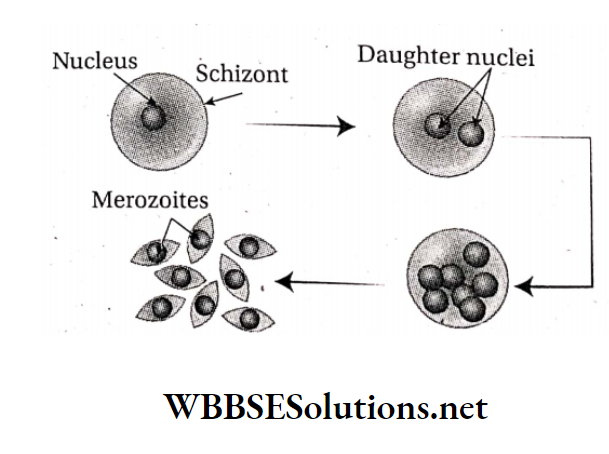
By this multiple fission, several hundreds of merozoites are formed, which again attack neighbouring liver cells and propagate in the same manner.
Inside the mosquito gut, the oocyst or sporont phase undergoes a similar type of multiple fission to produce sporozoites. This type of division is called sporogony.
Question 5. Briefly describe the asexual reproduction of Bryophyta, Pteridophyta, and fungi through spore formation.
Answer:
Bryophytes:
Bryophytes have two phases in their life cycle-the sporophytic (2n) and gametophytic (n) phases. The diploid sporophyte produces spores through meiosis in the specialized structure called sporangium.
All the spores are look alike i.e. homosporous. The sporangia are located in the capsule part of the sporophyte. The spores (n) are aplanospores, endogenous and when fall on a suitable substratum produce new gametophytes.
Pteridophyta:
In pteridophytes, spores (n) are formed by sporophytes (2n) in specialized sporangium. The spores may be homosporous or heterosporous. Homosporous spores are alike and produce a bisexual gametophyte.
Heterospores are of two types with microspores producing male gametophytes and megaspores producing female gametophyte. Spores are endogenous and haploid in nature as they are produced through meiosis from the spore mother cell.
Life Science Class 10 Wbbse
Fungi:
The spores in fungi may be endogenous in origin when produced in sporangia or may be exogenous origin like conidia produced by cutting the tip of fungi. In fungi, the endogenous spores are formed inside sporangia through mitosis.
The hyphal tip swells forming the sporangia. The nuclei undergo free nuclear division. Each nucleus with cytoplasm and membrane becomes a spore. The spores on suitable substratum germinate to produce new hypha.
Asexual Reproduction Methods
Question 6. What is meant by vegetative propagation? Briefly describe the processes of natural vegetative propagation. Part Question, ‘The adventitious leaf bud plays significant role in natural vegetative propagation of plant’-Evaluate the validity of the statement with a proper example.
Answer:
Vegetative propagation:
The asexual reproduction, in which any portion of the vegetative body of certain plants separates out from the mother’s body and finally grows into a new individual by mitotic cell division, is known as vegetative propagation.
Processes of natural vegetative propagation:
Vegetative propagation occurs by the growth of different parts of plants naturally, which are mentioned below.
1. By leaves:
Certain plants like Bryophyllum, Bigonia, etc. develop buds along the edges of their leaves. These are called leaf buds. These buds grow adventitious roots from their base.
When such a leaf detaches from the plant body and comes in contact with the soil, each of the buds grows into an individual daughter plant.
2. By roots:
Roots of sweet potato, pointed gourd, etc. grow adventitious buds. These are called root buds. When detached from the root, these buds grow into new daughter plants.
3. By stem:
Vegetative propagation by stem occurs by two different types of modified stems-
1. Underground modified stems:
The tuber of potato, bulb of onion, the rhizome of ginger, turmeric, etc. are underground stems, modified for storage of food. These organs have buds, which may grow into daughter plants.
2. Sub-aerial modified stems:
Nodes of sub-aerial modified stems of Mentha, Marsilea, Oxalis, Centella, water hyacinth, Chrysanthemum, etc. plants grow adventitious roots. When detached from the mother plant, the rooted branches grow as a daughter plant.
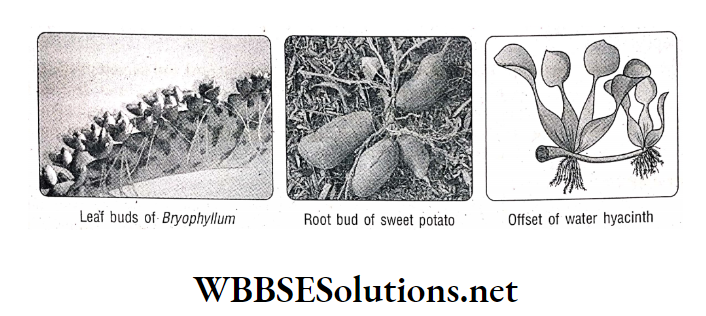
Question 7. Mention the advantages and disadvantages of vegetative propagation.
Answer:
Advantages of vegetative propagation:
- Identical character-bearing plants can be produced by vegetative propagation.
- By this process, several daughter plants may be produced from a single mother plant within a brief period of time.
- Vegetative propagation can be practiced in any season throughout the year.
- Desired characteristics of the mother plant remain intact in the daughter plants.
Disadvantages of vegetative propagation:
- Daughter plants from vegetative propagation do not have any newer characters.
- The daughter plants formed by this type of reproduction do not show any variation. Therefore, these plants cannot adapt themselves to the changed environment.
- Vegetative propagation does not provide any chance for evolution of a new species. Hence, there is a chance of extinction.
Question 8. How is layering technique used for artificial vegetative propagation of certain plants? How is the “gootee” prepared for artificial vegetative propagation in certain plants?
Answer:
Use of layering technique for artificial vegetative propagation:
In the layering technique, a comparatively young and tender twig is bent, such that the nodal portion of it touches the soil. Now, the portion of the branch, touching the ground, is covered with a layer of moistened soil and then a brick or stone is placed on it.
The layered portion is watered regularly. After a few weeks, adventitious roots develop from that portion of the stem under the soil.
The branch is then chopped off from the mother plant and the twig with roots is planted elsewhere to grow further as a progeny. Layering is applicable to plants like lemon, jasmine, wood-apple etc.
Preparation of “Gootee” for artificial vegetative propagation:
In this artificial vegetative propagation technique, a strong and stiff twig of a shrub or tree is selected to prepare a Gootee. First, a few inches of the bark is peeled off with a knife.
Now this portion is covered with a muddy mixture of organic manure and soil. Then the soil layer is wrapped with moistened rag or coir. An additional layer of polythene sheet may be wrapped to prevent quick drying.
After a few weeks, adventitious roots grow there and appear on the surface of the goatee. Now, the twig is chopped off and used for plantation. Gootee is applicable in plants like mango, guava, litchi, etc.
Life Science Class 10 Wbbse
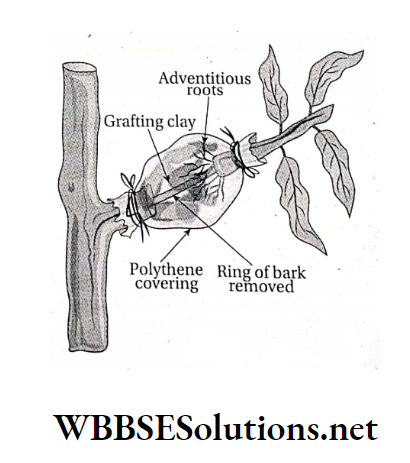
Question 9. Briefly describe the methods of cutting and grafting for artificial vegetative propagation.
Answer:
Methods of artificial vegetative propagation:
Artificial vegetative propagation of plants is done in different ways, which are mentioned below.
1. Cutting:
In this process, 20- 30 cm long twigs of certain plants are cut up from the mother plant. These are then planted in moistened soil.
Within a week or so, adventitious roots develop from the nodes and the twig grows as an individual plant. Cutting is successfully practiced upon the rose, china rose, drumstick plants, etc.
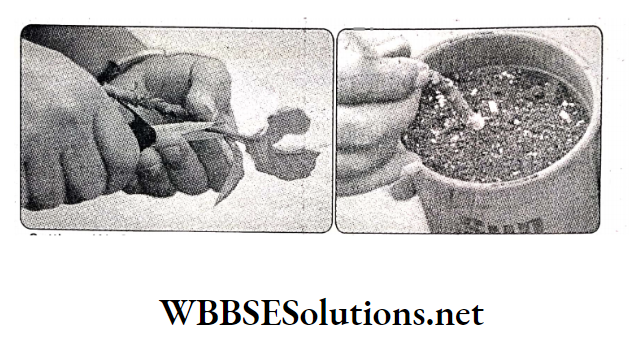
2. Grafting:
Grafting is the process of artificial vegetative propagation by which younger branches or buds of a superior variety of plants are affixed with an older and healthy stem of the same species to grow better varieties of plants in a short time.
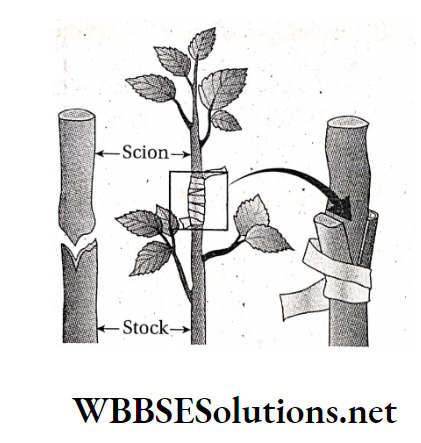
It is of two types:
- Scion grafting and
- Bud grafting.
1. Scion grafting:
In scion grafting, stems of two different varieties of plants are attached together. Of these two, the stem of the older one is chopped off leaving a portion of it above the ground. This rooted portion is called the stock.
A younger stem branch with superior features is affixed with the stock, which is called the scion. The end of the scion is cut with a sharp knife to give it a shape of a wedge.
The top or side of the stock is also cut to allow the scion to fit there perfectly. This region is wrapped with a moist rag or coir. After some days, the scion joins to the stock and grows further.
Life Science Class 10 Wbbse
2. Bud grafting:
In this process, axillary bud from a superior variety of plants is sliced off. Now a T-shaped slit is made on the bark of a healthy quick-growing plant of the same species. The bud is then fitted in the slit and is tied with string.
Finally, the bud joins to the stem and grows as a branch with superior features. Grafting is applicable for plants like mango, guava, litchi, etc.
Question 10. Classify sexual reproduction based on the nature of gametes. Name the different types of asexual reproduction with example.
Answer:
Types of sexual reproduction:
Based on the nature of gametes, sexual reproduction can be classified into three types.
These are
- Anisogamy: It occurs by the union of two morphologically non-identical gametes.
- Isogamy: It occurs by the union of two morphologically and physiologically identical gametes.
- Oogamy: This type of sexual reproduction occurs by the union of a smaller motile and a larger non-motile gamete.
Types of asexual reproduction:
In the living world, different types of asexual reproduction are seen.
These are
- Fission (Amoeba, Plasmodium),
- Budding (Yeast, Hydra),
- Fragmentation (Spirogyra),
- Sporulation (Moss, fern, fungi),
- Regeneration (Planaria).
Question 11. Mention the advantages and disadvantages of sexual reproduction.
Answer:
Advantages of sexual reproduction:
- By sexual reproduction, the genetic characters of the parents are inherited by the offspring and this event is carried forward in the following generations as well.
- In sexual reproduction, the recombination of genes takes place, which results in to the formation of new genetic variations.
- New genetic variations, which develop among the progeny, help them to adapt efficiently with the changing environment.
- Due to better adaptability, the progeny of sexual reproduction come out as a winner in the struggle for existence. They get the favour of natural selection and finally take part in the evolution of new species.
Disadvantages of sexual reproduction:
- Sexual reproduction is a slow process. Therefore, it takes a longer time to produce offspring.
- The availability of two different types of gametes is essential, which may not always be available.
- The success rate of fertilization depends upon a large number of male gametes, which may not always be available.
Question 12. Mention the advantages and disadvantages of asexual reproduction.
Answer:
Advantages of asexual reproduction:
- Asexual reproduction involves only one parental member, so it is an easier process.
- By this process, numerous offspring are produced at a time.
- This process needs very little energy.
- This is a very simple process and takes a very short time to complete.
- The parental features are retained within the progeny without any change.
- All progeny grow in close vicinity to its mother. Therefore, the progeny adapt easily to the known environment.
Disadvantages of asexual reproduction:
- Meiosis does not occur in asexual reproduction. Therefore, recombination of genes does not occur.
- Variations do not occur in the offspring of asexual reproduction.
- The chance of adaptability of these offspring is very low. Therefore, there is a possibility of their extinction.
Question 13. State the principle of micropropagation. Distinguish between asexual and sexual reproduction. 2+3 Or, Distinguish between asexual and sexual reproduction on the basis of the following features.
- Number of parents,
- Nature of offspring.
Answer:
Principle of micropropagation:
Certain plant cells have a unique ability to grow into a full plant body by means of cell division. This unique ability of plant cells is known as totipotency. Micropropagation is a tissue culture technique, which depends upon totipotency.
The word ‘micro’ means ‘very small. In micropropagation, very small portions are collected from vegetative parts of a plant and are cultured in a proper culture medium inside the laboratory to produce saplings.
Life Science Class 10 Wbbse
Differences between asexual and sexual reproduction

Question 14. Distinguish between vegetative propagation and asexual reproduction.
Answer:
Differences between vegetative propagation and asexual reproduction
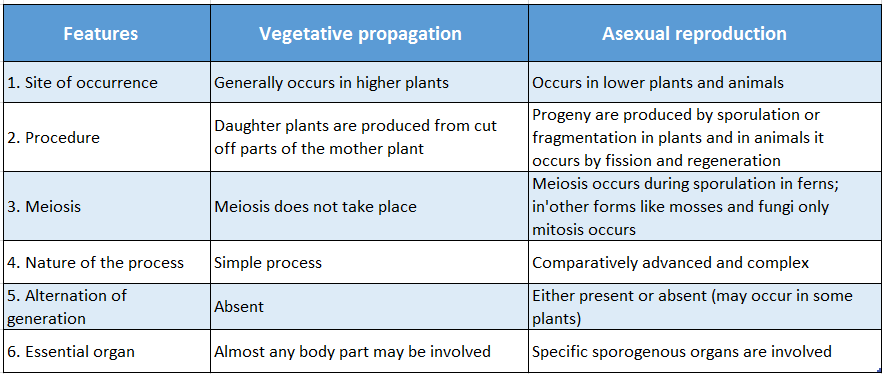
Question 15. What is meant by the alternation of generations? Mention the importance of meiosis in the alternation of generations.
Answer:
Alternation of generations:
The cyclic alternation between haploid gametophytic and diploid sporophytic generations in the life cycle of any sexually reproducing organism is called the alternation of generation.
Example:
In plants like moss, fern, etc., and protists like Paramoecium, Monocystis, etc. distinct alternation of generation is seen.
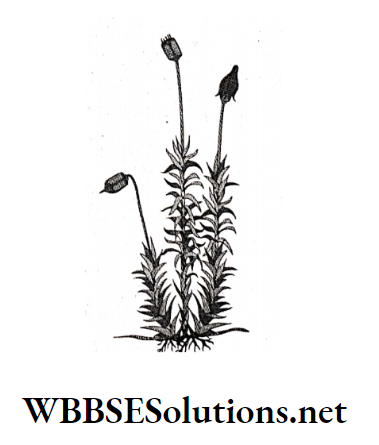
Importance of mitosis in alternation of generations:
During the alternation of generation, the cyclic rotation continues between haploid (n) and diploid (2n) generations. Diploid spore mother cells divide by meiosis to give rise to haploid spores.
These spores germinate to grow as haploid (n) gametophytes. The gametophytes carry separate gametangia to produce haploid male and female gametes. These gametes fertilise to form diploid zygotes to initiate the sporophytic generation.
That is why meiosis is important for the alternation of generations.
Question 16. With the help of a schematic diagram represent the alternation of generations in fern. Similar Question, Represent the alternation of generation in fern with a suitable schematic diagram.
Or,
Depict the alternation of generations in a fern with the help of a flowchart.
Answer:
Alternation of generations in fern:
In the life cycle of ferns, two distinct phases, namely the sporophytic (2n) phase, and gametophytic (n) phase, are present. The sporophytic phase is the predominant one, which is perennial and conspicuous.
Within the sporangia, diploid spore mother cells undergo meiosis to produce numerous haploid spores. With the formation of spores, the haploid gametophytic generation sporophyte starts. These spores germinate to form gametophytes.
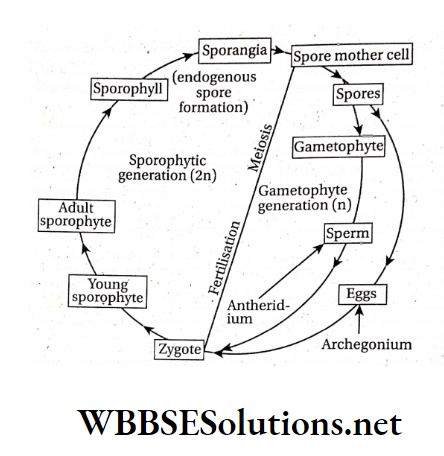
In ferns, the gametophytes are short-lived and inconspicuous. The gametophytes develop male and female gametangia, named as antheridia and archegonia respectively.
Within antheridia, haploid male gametes are produced and female gametes originate in archegonia. These gametes fertilize to form diploid zygospores to mark the onset of the next sporophytic generation.
Sexual Reproduction Explained
Question 17. Briefly describe the micropropagation technique. Mention its advantages. Or, How micropropagation is done?
Answer:
Technique of micropropagation:
The stepwise technique of micro- propagation are as follows-
- At first, a disease-free plant is selected and a portion from the plant body is cut off with a sharp, well-sterilized instrument. This plant part is called an explant.
- The explants is sterilized by treating it with 70% ethyl alcohol for 1 minute. and kept in 10% hypochlorite solution for 15 minutes for further sterilization.
- The explant is then placed in a culture medium containing sucrose and a mixture of growth regulators like auxin and cytokinin.
- The containers are placed on agitators in a completely sterile laboratory room in ambient temperature.
- After a few days, a cluster of undifferentiated cells grow from the explant, these are called callus. Later, the cells of the callus divide and differentiate to form tiny somatic embryos or embryoids.
- By controlled treatment of hormones, the embroids are grown as small plantlets. These are then transferred to sterilized soil to grow more. As the plantlets grow as saplings these are planted in natural soil for further growth.
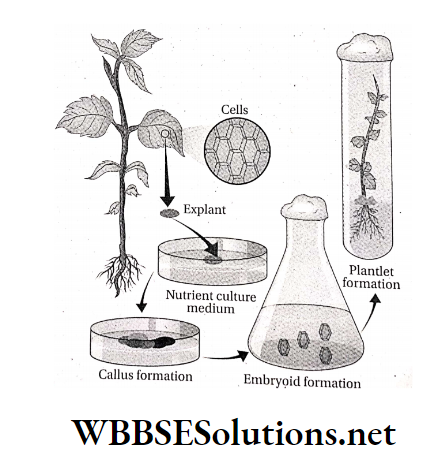
Advantages of micropropagation:
- By micropropagation, a large number of saplings can be formed in a small place.
- The saplings, produced by this process are healthy and disease free.
- By this process, desired varieties of plants can be produced at any season throughout the year.
- The plants, which are unable to perform sexual reproduction, can be propagated by micropropagation.
Chapter 2 Continuity Of Life Reproduction Short Answer Type Questions
Question 1. Mention two characteristic features of sexual reproduction.
Answer:
Two characteristic features of sexual reproduction are as follows-
- In sexual reproduction, two different gametes, i.e., male and female gametes, unite to form the offspring.
- The progenies are born with variations, which in the long run, help in the formation of new and evolved species.
Question 2. How is a definitive nucleus formed during the sexual reproduction of angiospermic plants?
Answer:
Within the embryo sac of ovule of flowers in angiospermic plants, two haploids (n) polar nuclei unite together. As a result, a diploid (2n) definitive nucleus is formed.
Polar nucleus (n) + Polar nucleus (n) = Definitive nucleus (2n)
Question 3. What is syngamy?
Answer:
Syngamy:
Syngamy is a the complete and permanent union of two different gametes, i.e., male and female gametes, outside the gametangia. Syngamy is found in all sexually reproducing organisms.
Question 4. What is oogamy?
Answer:
Oogamy:
Oogamy is a type of sexual reproduction, where a small and motile male gamete fertilizes a large and non-motile female gamete. This is noticed among some algae like Oedogonium, Chara, etc., and in all higher plants and animals.
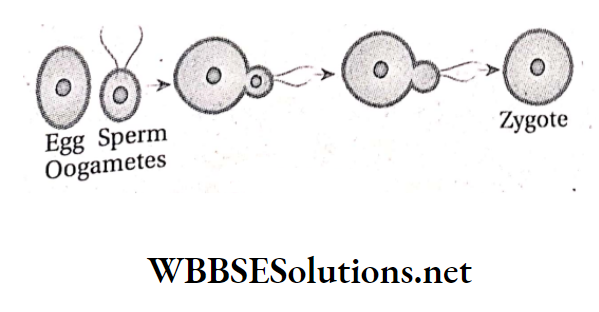
Question 5. What is isogamy?
Answer:
Isogamy:
Isogamy is a type of sexual reproduction where two morphologically and physiologically identical gametes unite to form a zygote. Isogamy occurs in certain lower organisms like Chlamydomonas, Monocystis, etc.
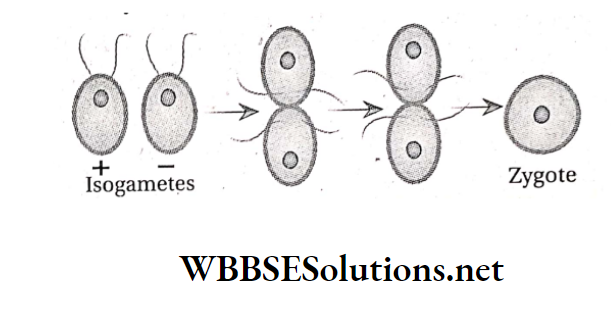
Question 6. What is anisogamy?
Answer:
Anisogamy:
Anisogamy is a type of sexual reproduction where two morphologically different gametes unite to form the zygote. This type of sexual reproduction is seen in certain species of Chlamydomonas.
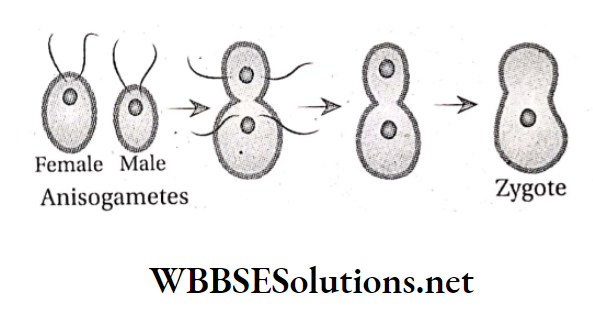
Question 7. What is meant by asexual reproduction?
Answer:
Asexual reproduction:
The type of reproduction, in which the formation of male and female gametes and their fertilization do not occur. Instead, certain body cells or specialized cells like spores divide to form the progeny. This is known as asexual reproduction.
Example of Asexual reproduction:
Fungi, like yeast and certain lower animals perform asexual reproduction.
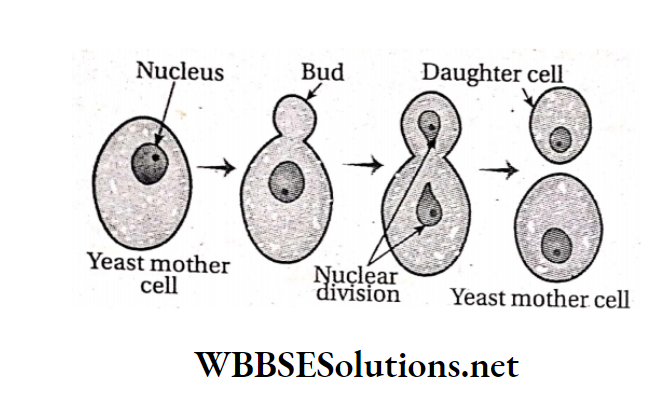
Question 8. What is meant by asexual reproduction by fission?
Answer:
Asexual reproduction by fission:
For propagation, most unicellular organisms undergo two or multiple number of cell divisions to form two or more offspring, either through mitosis or amitosis. This type of asexual reproduction is called fission.
Example of Asexual reproduction by fission:
Amoeba and Plasmodium perform asexual reproduction by binary and multiple fissions respectively.
Question 9. What is budding?
Answer:
Budding:
In certain lower organisms, a small portion of the vegetative body swells out as an outgrowth and finally, it gets detached from the mother body and grows as a new progeny. This type of asexual reproduction is called budding.
Example of Budding:
Budding is commonly seen in yeast and Hydra.
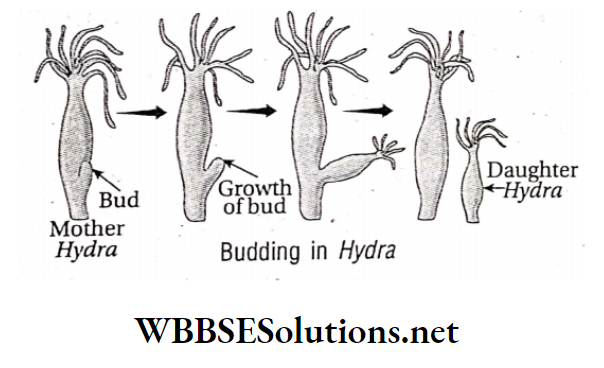
Importance of Reproduction for Species Continuity
Question 10. What are the different steps of budding in yeast?
Answer:
The different steps of budding in yeast:
Initiation of bud as outgrowth → Division of parent nucleus into two nuclei → Migration of one nucleus into bud→ Wall formation between parent cell and bud→ Detachment of bud and formation of new cell
Question 11. What is meant by sporulation?
Answer:
Sporulation:
In certain lower plants, numerous, typically thick-walled cells or spores are produced in sporangia. On attaining maturity, these spores are liberated from the mother plant and fall on the ground and finally germinate to form the new progeny.
This type of asexual reproduction is known as sporulation.
Example of Sporulation: Sporulation occurs in fungi, moss, fern, etc.
Question 12. What is multiple fission?
Answer:
Multiple fission:
Multiple fission is a type of asexual reproduction in which the parent nucleus undergoes free nuclear division forming a huge number of nuclei. Each nuclei absorb little ammount of cytoplasm and forms a membrane around it to form a new daughter cell.
Example of Multiple fission: Amoeba.
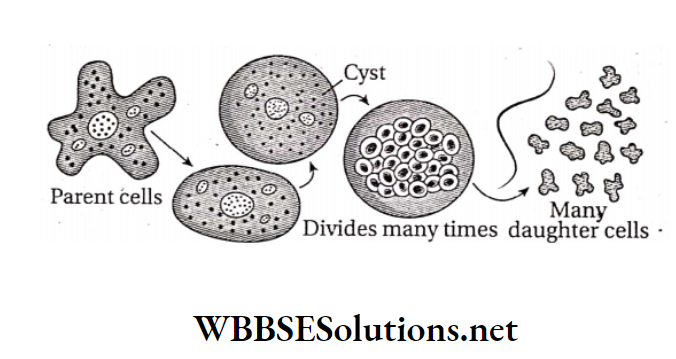
Question 13. What is meant by regeneration?
Answer:
Regeneration:
The process of asexual reproduction in which, a new progeny is formed from a fragment of the parent’s body, is known as regeneration.
Example of Regeneration: Planaria propagates by regeneration.
Question 14. What is meant by fragmentation?
Answer:
Fragmentation:
Filaments of certain lower plants often tear apart into fragments due to mechanical impact. By mitotic cell division, all these fragments may grow as individual progenies.
This type of vegetative propagation is known as fragmentation, for example-Spirogyra performs asexual reproduction by fragmentation.
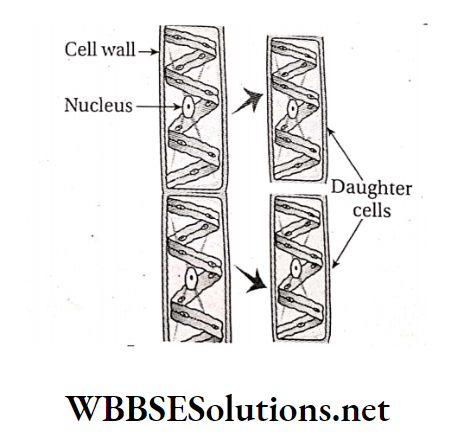
Question 15. What is binary fission?
Answer:
Binary fission:
Binary fission is a type of asexual reproduction found in some prokaryotes and some unicellular eukaryotes in which the parent cell divides amitotically into two daughter cell.
Example of Binary fission: Amoeba.
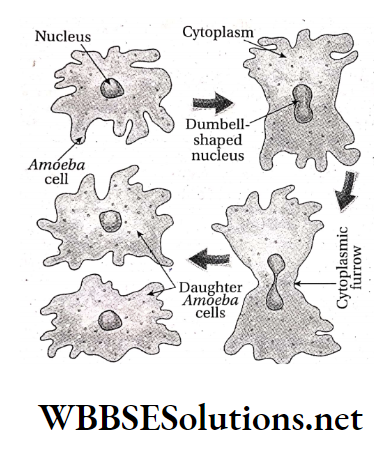
Question 16. What are the different type of fission found in Amoeba?
Answer:
The different type of fission found in Amoeba:
Amoeba is an unicellular eukaryote which reproduces asexually by two methods binary fission and multiple fission.
Amoeba produces two daughter cells from parent cells at a time by binary fission and numerous daughter cells by free nuclear division through multiple fission.
Question 17. What are zoospores?
Answer:
Zoospores:
Certain asexual spores are capable of locomotion with the help of cilia or flagella. These spores are called zoospores.
Example of Zoospores:
Spores of Volvox, Chlamydomonas, etc. are zoospores.
Question 18. What are aplanespores?
Answer:
Aplanespores:
The non-motile asexual spores, which do not possess any locomotory organ, are known as aplanospores.
Example of Aplanespores: Spores of Mucor, Penicillum, etc. are aplanospores.
Question 19. What is meant by zygospore?
Answer:
Zygospore:
In certain lower organisms, two different gametes unite to form a diploid cell by conjugation, which develops a thick protective is known as a zygospore.
Example of Zygospore:
Spirogyra, cell wall to form a typical spore. This type of spore Oedogonium have zygospores.
Question 20. What is propagule?
Answer:
Propagule:
The plant part from which a new plant is formed during reproduction is called the propagule. Bud is a propagule of asexual reproduction and seed is a propagule of sexual reproduction.
Question 21. What are the processes of asexual reproduction in spirogyra and planaria?
Answer:
Spirogyra mediates their reproduction by fragmentation, whereas planaria make it by regeneration.
Question 22. What is gametophyte and sporophyte?
Answer:
Gametophyte and sporophyte:
The plant gamete which is produced from spore and produces gamete is called gametophyte. The plant which is produced from a zygote and produces a spore is called a sporophyte.
Question 23. What is meant by artificial vegetative propagation?
Answer:
Artificial vegetative propagation:
In the practice of agriculture and horticulture, vegetative propagation of different plants is done under human manipulation. This is known as artificial vegetative propagation.
Question 24. What is stolen?
Answer:
Stolen:
The internodes of certain herbs grow to form arches which remain above the ground. However, their nodes remain affixed with the soil by adventitious roots.
This type of sub-aerial modified stem is known as stolon, which is seen in plants like Mentha, strawberry, etc.
Question 25. Give examples of a few plants, which naturally perform vegetative propagation.
Answer:
Many plants naturally perform vegetative propagation. These include sweet potato, potato, pointed gourd, onion, Bryophyllum, etc.
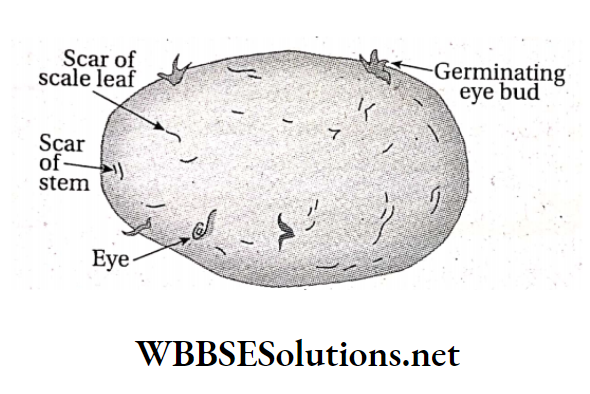
Question 26. What is meant by stock and scion?
Answer:
Stock and scion:
In grafting, stems of two different varieties of plants are attached together. Of these two, the stem of the older plant is chopped off leaving a portion of it above the ground.
This rooted portion is called the stock and the younger stem branch with superior features which is affixed with the stock, is called the scion.
Question 27. Why grafting is not possible in paddy or maize plants.
Answer:
During grafting, stems of two different varieties of plant are attached together at the cambium region. So, for the grafting process, cambium plays a major role.
But paddy and maize, are monocot in nature and they do not contain cambium. So due to a lack of cambium, grafting is not possible in these plants.
Question 28. Which type of root is seen in sweet potato and what is its function?
Answer:
Fleshy tuberous adventitious roots are seen in sweet potatoes. The function of the roots of sweet potatoes is to store food. It also helps in vegetative propagation.
Question 29. Distinguish between cutting and grafting.
Answer:
Distinguishing features between cutting and grafting are-

Question 30. What is micropropagation?
Answer:
Micropropagation:
The process by which tissues, cells, protoplasts or organs are collected from plants and cultured in laboratories within proper nutritive medium to produce progeny plants, is known as micropropagation.
By means of micro- propagation large number of identical progeny plants, can be produced within a short period.
Question 31. What is totipotency?
Answer:
Totipotency:
The inherent ability of any cell to divide and develop into a full-grown plant under proper environmental conditions outside the living body is known as totipotency.
Due to this unique ability, small segments of plant tissue can be cultured within the laboratories to produce tiny saplings from it.
Question 32. Mention two distinctive features of micropropagation.
Answer:
Two distinctive features of micropropagation are as follows-
- Micropropagation is a tissue culture technique by which several clones of plants can be produced vegetatively.
- By this process, the number of desired varieties of plants can be increased within a short time.
Question 33. Mention the disadvantages of micropropagation.
Answer:
The disadvantages of micropropagation-
- In micropropagation, no genetic variations are developed. Therefore, the plants produced in this process have lesser adaptability.
- Due to a lack of variation, micropropagation reduces the chance of evolution.
Question 34. What is meant by tissue culture?
Answer:
Tissue culture:
The biotechnological process in which tissues, collected from different organisms are cultured in the laboratory within a proper nutritive culture medium, under a suitable sterile environment, is known as tissue culture.
This process can form sprouts within laboratories from small plant tissues.
Question 35. Which plant hormones are mixed with a special tissue culture medium and why?
Answer:
Auxin and cytokinin are the hormones which are mixed in a special tissue culture medium. These two hormones regulate the growth of the cultured tissues. Therefore, these two growth regulators are used in tissue culture medium.
Comparative Study of Asexual and Sexual Reproduction
Question 36. What are explants?
Answer:
Explants:
The small plant parts, tissues, or cells, which are collected from plant bodies for culturing in laboratories, are called explants. The meristematic tissue-rich portions of plants, like apical buds, root tips, and tubers are mostly collected as explants.
Question 37. What is a callus?
Answer:
Callus:
While growing in sterile culture media, mitosis starts in explants. After some time, a cluster of undifferentiated cells are produced from the cells of explants.
This cluster of cells is known as a callus. The cells of the callus are totipotent in nature, which may divide to form a full-grown plant.
Question 38. What is meant by caulogenesis?
Answer:
Caulogenesis:
The development of stem from a callus, within a tissue culture medium, is called caulogenesis. This is a tissue differentiation process, which is initiated by a higher concentration of auxin and cytokinin in the culture medium.
Question 39. What is meant by histogenesis?
Answer:
Histogenesis:
The development of a root from a callus, within a tissue culture medium, is called histogenesis. This is a tissue differentiation process, which is initiated by a lower concentration of auxin and cytokinin in the culture medium.
Question 40. What is meant by histogenesis?
Answer:
Histogenesis:
The development of xylem and phloem tissues by the differentiation of a callus within a tissue culture medium is called histogenesis. This is a tissue differentiation process, which is regulated by auxin and cytokinin in the culture medium.
Question 41. What is an alternation of generations?
Answer:
Alternation of generations:
The alternation of a haploid (n) and a diploid (2n) generation in the life cycle of an organism showing sexual reproduction is called the alternation of generations.
Example: Fern.
Question 42. Mention the importance of the alternation of generations.
Answer:
The importance of the alternation of generations:
The cyclic rotation of haploid and diploid generations helps in keeping the chromosome number constant. The alternation of generations also helps in maintaining the genetic identity of any organism for generations.
Chapter 2 Continuity Of Life Reproduction Very Short Answer Type Questions Multiple Choice Questions And Answers [Mcq]
Question 1. Which of the following organisms performs reproduction by fission?
- Plasmodium
- Hydra
- Fern
- Planaria
Answer: 1. Plasmodium
Question 2. Which of the following organisms performs reproduction by budding?
- Amoeba
- Plasmodium
- Hydra
- Planaria
Answer: 3. Hydra
Question 3. Amoeba performs—
- Fission
- Budding
- Fragmentation
- Sporulation
Answer: 1. Fission
Question 4. Yeasts reproduce by—
- Fragmentation
- Sporulation
- Regeneration
- Budding
Answer: 4. Budding
Question 5. Which of the following organisms does not perform reproduction by spore formation?
- Moss
- Planaria
- Fern
- Fungi
Answer: 2. Planaria
Question 6. Fragmentation is seen in—
- Hydra
- Yeast
- Plasmodium
- Spirogyra
Answer: 4. Spirogyra
Question 7. Which of the following organisms performs reproduction by regeneration?
- Hydra
- Spirogyra
- Planaria
- Amoeba
Answer: 3. Planaria
Question 8. Adventitious bud formation occurs in the leaves of which of the following plants?
- Sweet potato
- Potato
- Water hyacinth
- Bryophyllum
Answer: 4. Bryophyllum
Question 9. Which of the following organisms performs reproduction by sporulation?
- Fungi
- Planaria
- Hydra
- Amoeba
Answer: 1. Fungi
Question 10. An example of the juicy root is—
- Water hyacinth
- Sweet potato
- Potato
- Bryophyllum
Answer: 2. Sweet potato
Question 11. Which of the following organisms shows both asexual as well as sexual reproduction?
- Hydra
- Amoeba
- Paramoecium
- Horse
Answer: 3. Paramoecium
Question 12. Grafting is a technique of—
- Sexual reproduction
- Asexual reproduction
- Vegetative propagation
- Parthenogenesis
Answer: 3. Vegetative propagation
Question 13. Reproduction in plants by cutting method is a type of—
- Artificial vegetative propagation
- Asexual reproduction
- Sexual reproduction
- Natural vegetative propagation
Answer: 1. Artificial vegetative propagation
Question 14. The reproductive stage, produced by the conjugation of similar gametes, is called
- Zygote
- Zygospore
- A zygospore
- Oospore
Answer: 2. Zygospore
Question 15. Which of the following performs reproduction by conjugation?
- Spirogyra
- Mucor
- Moss
- Fern
Answer: 1. Spirogyra
Question 16. Fern performs reproduction by—
- Budding
- Fragmentation
- Spore formation
- Regeneration
Answer: 3. Spore formation
Question 17. Fertilized ovum is known as—
- Spermatozoon
- Zygote
- Zygospore
- Spore
Answer: 2. Zygote
Question 18. An unfertilized egg, taking part in parthenogenesis, is known as—
- Zygote
- Zygospore
- A zygospore
- Oospore
Answer: 3. Azygospore
Question 19. The process of ovum formation is called—
- Spermatogenesis
- Oogenesis
- Parthenogenesis
- Gametogenesis
Answer: 2. Oogenesis
Question 20. The process of sperm formation is known as—
- Spermatogenesis
- Oogenesis
- Parthenogenesis
- Gametogenesis
Answer: 1. Spermatogenesis
Question 21. The Union of two identical gametes is called—
- Isogamy
- Anisogamy
- Oogamy
- Syngamy
Answer: 1. Isogamy
Question 22. The process of reproduction, in which offspring are formed by the division of body cells without the union of gametes, is called—
- Sexual reproduction
- Vegetative propagation
- Asexual reproduction
- Parthenogenesis
Answer: 3. Asexual reproduction
Question 23. In which of the following organisms sexual dimorphism is seen?
- Cockroach
- Earthworm
- Amoeba
- Plasmodium
Answer: 1. Cockroach
Question 24. External fertilization takes place in which of the following animals?
- Human
- Fish
- Deer
- Horse
Answer: 2. Fish
Question 25. Which of the following is an example of a hermaphroditic animal?
- Cockroach
- Snake
- Earthworm
- Toad
Answer: 3. Earthworm
Question 26. The formation of offspring from unfertilized egg is known as—
- Paedogenesis
- Parthenogenesis
- Parthenocarpy
- Oogenesis
Answer: 2. Parthenogenesis
Question 27. The process of asexual reproduction in bacteria is known as—
- Binary fission
- Fragmentation
- Multiple fission
- Mitosis
Answer: 1. Binary fission
Question 28. Which of the following plants performs reproduction by means of root buds?
- Rose
- Dahlia
- Pointed gourd
- Bryophyllum
Answer: 3. Pointed gourd
Question 29. The animal in which unfertilized eggs develop into offspring is—
- Toad
- Honey bee
- Pigeon
- Fish
Answer: 2. Honey bee
Question 30. Spore formation, from the spore mother cells in ferns, occurs by—
- Meiosis
- Amitosis
- Mitosis
- Binary fission
Answer: 1. Meiosis
Question 31. Sexual phase of alternation of generation is called—
- Gametophytic phase
- Sporophytic phase
- Gamete
- Parthenogenesis
Answer: 1. Gametophytic phase
Question 32. The asexual phase of alternation of generation in a plant is known as—
- Gametophytic phase
- Sporophytic phase
- Embryo
- Oogenesis
Answer: 2. Sporophytic phase
Question 33. The haploid phase of the alternation of generation in fern is—
- Gametophytic
- Sporophytic
- Parthenocarpic
- Both 1 and 2
Answer: 1. Gametophytic
Question 34. The sporophytic phase of the alternation of generation in fern is—
- Haploid (n)
- Diploid (2n)
- Triploid (3n)
- Quadruploid (4n)
Answer: 2. Diploid (2n)
Question 35. Vo I vox reproduces by—
- Sexual reproduction
- Asexual reproduction
- Vegetative propagation
- Parthenogenesis
Answer: 2. Asexual reproduction
Question 36. The modified sub-aerial stem of water hyacinth, which helps it in vegetative propagation, is called—
- Sucker
- Offset
- Runner
- Stolon
Answer: 2. Offset
Question 37. The buds, present on the margins of leaves of Bryophyllum, are called—
- Leaf buds
- Epiphytic buds
- Terminal buds
- Lateral buds
Answer: 1. Leaf buds
Question 38. Artificial vegetative propagation involving stock and scion is known as—
- Cutting
- Gootee
- Grafting
- Layering
Answer: 3. Grafting
Question 39. Artificial vegetative propagation which is applied for china rose and marigold, is—
- Cutting
- Gootee
- Grafting
- Layering
Answer: 1. Cutting
Question 40. The plant that performs vegetative propagation by bulbil is—
- Sweet potato
- Oxalis
- Air potato (Dioscorea)
- Dahlia
Answer: 3. Air potato (Dioscorea)
Question 41. A hermaphrodite animal that can perform self-fertilization is—
- Toad
- Liver fluke
- Ascaris
- Salamander
Answer: 2. Liver fluke
Question 42. A plant hormone, provided externally in tissue culture medium is—
- Thyroxine
- Artificial auxin
- Insulin
- Glucagon
Answer: 2. Artificial auxin
Question 43. Method of cloning is an example of—
- Micropropagation
- Genetic engineering
- Biotechnology
- All of these
Answer: 4. All of these
Question 44. The artificial reproduction in which culture medium is required is called—
- Cutting
- Grafting
- Micropropagation
- All of these
Answer: 3. Micropropagation
Question 45. Other than Planaria, which of the following animals shows regeneration?
- Spongilla
- Amoeba
- Pogonatum
- Paramoecium
Answer: 1. Spongilla
Question 46. The event of growth of any organism within the uterus is known as—
- Alternation of generation
- Vivipaiy
- External fertilisation
- Internal fertilisation
Answer: 2. Vivipaiy
Question 47. The physiological process by which an organism produces its own replica is known as—
- Respiration
- Circulation
- Excretion
- Reproduction
Answer: 4. Reproduction
Question 48. In grafting, the cut branch of the superior plant is called a ‘scion’. The inferior rooted portion, on which it is fixed, is called—
- Bark
- Stem
- Stock
- Bulb
Answer: 3. Stock
Question 49. The cutting, by which sugarcane plants can be propagated, is collected from—
- Root
- Stem
- Leaf
- All of these
Answer: 2. Stem
Question 50. A complete and permanent union of two identical gametes is called—
- Isogamy
- Anisogamy
- Syngamy
- Heterogamy
Answer: 3. Syngamy
Question 51. union of two male and female gametes of unequal size and shape is called—
- Isogamy
- Anisogamy
- Syngamy
- Heterogamy
Answer: 3. Anisogamy
Question 52. The presence of an organ, which is essential to distinguish between male and female of any unisexual organism, is called—
- Reproductive organ
- Respiratory organ
- Excretory organ
- Sensory organ
Answer: 1. Reproductive organ
Question 53. The continuous alternation of haploid and diploid generations in the life cycle of certain organisms is called—
- Alternation of generation
- Reproduction
- Conjugation
- Transformation
Answer: 1. Alternation of generation
Question 54. The cell division, by which the zygotes of higher plants and animals develop into full-grown organisms, is called—
- Meiosis
- Mitosis
- Both 1 and 2
- Amitosis
Answer: 2. Mitosis
Question 55. The fertilization between male and female gametes of higher organisms is known as—
- Isogamy
- Anisogamy
- Oogamy
- Syngamy
Answer: 3. Oogamy
Question 56. The first object produced from explants during micropropagation is—
- Callus
- Stock
- Scion
- Spore
Answer: 1. Callus
Question 57. The unequal-sized spores produced during asexual reproduction are called—
- Parthenocarpic
- Anthers
- Homospores
- Heterospores
Answer: 4. Heterospores
Question 58. Spores which are produced within sporangium, are called—
- Sporangiospores
- Aplanospores
- Zoospores
- Zygospores
Answer: 1. Sporangiospores
Question 59. An animal, capable of reproducing by sexual, asexual, and vegetative means, is—
- Spirogyra
- Hydra
- Spirogyra
- Hydra
Answer: 3. Spirogyra
Question 60. An animal,which performs asexual, asexual, and vegetative means is
- Spirogyra
- Hydra
- Spirogyra
- Hydra
Answer: 4. Hydra
Question 61. An aquatic organism that performs internal fertilization is—
- Mrigel fish
- Shark
- Rohu fish
- Catla fish
Answer: 2. Shark
Question 62. An example of an ovoviviparous animal is—
- Rohu fish
- Prawn
- Shark
- Whale
Answer: 3. Shark
Question 63. A plant that shows viviparous germination
- Garan
- Papaya
- Mango
- Pumpkin
Answer: 1. Garan
Question 64. The formation of offspring from any cut-off organs of a plant is called—
- Development
- Regeneration
- Transformation
- Reconstruction
Answer: 2. Regeneration
Question 65. The chromosome number of sperm is—
- Diploid
- Triploid
- Haploid
- Tetraploid
Answer: 3. Haploid
Question 66. The chromosome number of a zygote is—
- 2n
- n
- 3n
- 4n
Answer: 1. 2n
Question 67. The chromosome number of the ovum is—
- Diploid
- Triploid
- Pentaploid
- Haploid
Answer: 4. Haploid
Question 68. The capability of any tissue cell to form an entire plant body is called—
- Alternation of generation
- Parthenogenesis
- Totipotency
- Transformation
Answer: 3. Totipotency
Question 69. Which of the following pair is correct?
- Budding—Yeast
- Fragmentation—Earthworm
- Spore formation—Amoeba
- Regeneration—Dryopoteris
Answer: 1. Budding—Yeast
Question 70. Which one of the following statements is correct regarding sexual reproduction?
- Haploid gamete formation is essential in sexual reproduction
- Sexual reproduction depends only on mitosis
- In sexual reproduction, offspring could be produced from a single parental organism.
- The offsprings produced in sexual reproduction are genetically identical with a parental organism.
Answer: 1. Haploid gamete formation is essential in sexual reproduction
Question 71. Select the correct pair and write it—
- Multiple fission—Hydra
- Fragmentation—Spirogyra
- Regeneration—Fern
- Budding—Planaria
Answer: 2. Fragmentation—Spirogyra
Chapter 2 Continuity Of Life Reproduction Answer In A Single Word Or Sentence
Question 1. What is the process of formation of similar or dissimilar character-bearing offspring from parent organism called?
Answer: Reproduction
Question 2. What is the main cause of reproduction?
Answer: To maintain the race of a species
Question 3. What is the unit of sexual reproduction?
Answer: Gamete
Question 4. In which organ the spores for asexual reproduction of a plant are produced?
Answer: Sporangium
Question 5. What is produced after the union of sperm and ovum, during sexual reproduction?
Answer: A zygote is produced.
Question 6. Name a dioecious or unisexual plant.
Answer: Papaya plant
Wbbse Class X Life Science
Question 7. Name a bisexual but monoecious plant.
Answer: Mango plant
Question 8. Name a bisexual flower.
Answer: China rose (Hibiscus sp.)
Question 9. Name a unisexual flower.
Answer: Flower of pumpkin is a unisexual flower.
Question 10. Which is the unit of asexual reproduction of a plant?
Answer: Spore is the unit of asexual reproduction of a plant.
Question 11. Which type of reproduction is performed by Amoeba?
Answer: Amoeba performs asexual reproduction.
Question 12. Name a plant, which shows alternation of generation in its life cycle.
Answer: Selaginella (a fern)
Question 13. Name an animal, which shows an alternation of generations in its life cycle.
Answer: Obelia (a cnidarian)
Common Reproductive Strategies in Animals
Question 14. Name an animal, which performs reproduction by conjugation.
Answer: Paramoecium (a protist)
Question 15. Name an animal, which can reproduce by parthenogenesis.
Answer: Honey bee
Question 16. Name an oviparous animal.
Answer: Bird
Question 17. Name a viviparous animal.
Answer: Human
Question 18. Name the event of the union of male and female gametes in sexual reproduction.
Answer: Fertilisation
Wbbse Class X Life Science
Question 19. Name two hormones used for micropropagation.
Answer: Auxin and cytokinin
Question 20. In which type of reproduction new genetic features may appear in the offspring?
Answer: In sexual reproduction, new genetic features may appear in the offspring.
Question 21. By which process does Spirogyra perform sexual reproduction?
Answer: Spirogyra performs sexual reproduction by conjugation.
Question 22. Which type of offspring are produced in asexual reproduction?
Answer: The offspring produced in asexual reproduction, become genetically identical to its parents, i.e., no genetic variation occurs.
Question 23. How does the body fragment of a Planaria grow into a fully formed one?
Answer: By regeneration.
Question 24. How do you denote the union of a male and a female gamete of identical shape and size?
Answer: Isogamy.
Question 25. What is heterogamy?
Answer: Heterogamy is the union of two gametes with non-identical sizes and shape.
Question 26. How do you refer to the union of two gametes, produced in the body of the same animal?
Answer: The union of two gametes, produced in the body of the same organism, is called self-fertilization.
Question 27. How do you refer to the union of two gametes, produced in two different animals?
Answer: The union of two gametes, produced in two different animals, is called cross-fertilization.
Question 28. Name the type of fertilization that occurs in an open environment, outside the animal body.
Answer: External fertilization
Wbbse Class X Life Science
Question 29. Which phase of life cycle starts in an organism with the formation of haploid spores?
Answer: Gametophytic generation starts with the formation of haploid spores, in the life cycle of an organism.
Question 30. Name an organism, which performs asexual reproduction by multiple fission.
Answer: Plasmodium
Question 31. Name the process of fertilization of male and female gametes in the sexual reproduction of higher organisms.
Answer: The process of fertilization of male and female gametes in the sexual reproduction of higher organisms is known as oogamy.
Question 32. Upon which type of cell division does sexual reproduction depend directly?
Answer: Meiotic cell division
Question 33. Which type of cell division occurs during the gametogenesis of sexually reproducing higher organisms?
Answer: In higher organisms, meiotic cell division occurs during gametogenesis.
Question 34. Which type of cell division occurs during the sporogenesis of ferns and mosses?
Answer: Meiotic cell division
Question 35. Which type of cell division occurs during spore formation in Mucor and Penicillium?
Answer: Mitosis
Question 36. Which type of reproduction helps in creating variations among offspring?
Answer: Sexual reproduction
Wbbse Class X Life Science
Question 37. Name one organism that can reproduce through a motile spore.
Answer: Chlamydomonas
Question 38. Name one organism that can reproduce through a nonmotile spore.
Answer: Mucor
Question 39. Name fungi that reproduce through conidia.
Answer: Penicillium
Question 40. Give one example of a fleshy not, helping in vegetative reproduction.
Answer: Sweet potato
Question 41. Which plant vegetatively reproduces through stolon?
Answer: Mentha
Question 42. Which plant reproduces through a leaf?
Answer: Bryophyllum
Question 43. Who discovered micropropagation?
Answer: Frederick Campion Steward
Wbbse Class 10 Life Science Solutions
Question 44. Micropropagation is based on which property of a cell?
Answer: Totipotency
Question 45. What is a plantlet?
Answer: The small plants produced through micropropagation are called plantlets.
Question 46. Name one organism that reproduces through Conjugation.
Answer: Paramoecium
Question 47. What is the torula stage?
Answer: The bud of yeast looks like the animal Torula hence this stage is called the torula stage.
Question 48. What is syngamy?
Answer: Syngamy is the fusion of two different gametes.
Question 49. What is rhizogenesis?
Answer: Rhizogenesis is the production of roots in callus culture.
Question 50. Name one animal showing, vegetative, asexual, and sexual reproduction.
Answer: Hydra sp.
Chapter 2 Continuity Of Life Reproduction Fill In The Blanks
Question 1. A progeny comes from _________ generation.
Answer: Parental
Question 2. The individual of a new generation that originates from the parental generation is known as _________.
Answer: Offspring
Question 3. The number of a population _________ by reproduction.
Answer: Increases
Question 4. In sexual reproduction, _________ originate in a population.
Answer: Variations
Question 5. In asexual reproduction, only _________ parent is required.
Answer: One
Question 6. The union of male and female gametes is known as _________.
Answer: Fertilisation
Question 7. Based on the nature of gametes, sexual reproduction can be classified into _________ types.
Answer: Three
Wbbse Class 10 Life Science Solutions
Question 8. The sexual reproduction, in which the sizes of male and female gametes are unequal, is called _________.
Answer: Anisogamy
Question 9. The sexual reproduction, in which the sizes of male and female gametes are identical, is called _________.
Answer: Isogamy
Question 10. The sexual reproduction, in which the male gametes are small and motile, whereas the female gamete is large and non-motile, is called _________.
Answer: Oogamy
Question 11. Daughter cells of Plasmodium, produced by schizogony, are called _________.
Answer: Merozoites
Question 12. Daughter cells of Plasmodium, produced by sporogony, are called _________.
Answer: Sporozoites
Question 13. Planaria can perform asexual reproduction by _________ of its body fragments.
Answer: Regeneration
Question 14. Numerous _________ are produced from the sporogenous tissue of moss.
Answer: Spores
Question 15. Bryophyllum performs vegetative propagation by the on _________ its leaf margins.
Answer: Buds
Question 16. _________ is a type of tissue culture technique.
Answer: Micropropagation
Question 17. Spore-producing plants are known as _________ plants.
Answer: Sporophytic
Question 18. The _________, used in the grafting process, carries the superior characteristics of a plant.
Answer: Scion
Question 19. The diploid cell produced by fertilisation is _________.
Answer: Zygote
Question 20. Spore is formed within _________.
Answer: Sporangium
Chapter 2 Continuity Of Life Reproduction State True Or False
Question 1. The production of new offspring by a parental generation is called reproduction.
Answer: True
Question 2. Like nutrition, respiration or excretion, reproduction is also an essential life process of the living organisms.
Answer: False
Question 3. The unit of sexual reproduction is the gamete.
Answer: True
Question 4. The unit of vegetative propagation is spore.
Answer: False
Question 5. Amoeba divides by mitosis.
Answer: False
Question 6. Plasmodium reproduces by fragmentation.
Answer: False
Question 7. Yeast reproduces by spore production.
Answer: False
Question 8. Micropropagation is none other than a technique of tissue culture.
Answer: True
Question 9. Potato reproduces by stem buds.
Answer: True
Wbbse Class 10 Life Science Solutions
Question 10. Bryophyllum reproduces by root buds.
Answer: False
Question 11. Water hyacinth performs vegetative propagation by stolon.
Answer: False
Question 12. Birds show distinct alternations of generation.
Answer: False
Question 13. Scion, used in grafting, bears superior character.
Answer: True
Question 14. Apomixis is a process by which certain organisms can produce their progeny, without- out fertilization.
Answer: True
Question 15. The haploid phase of the alternation of generation in an organism is none other than the sexual phase.
Answer: True
Question 16. Fertilization is the union of male and female gametes.
Answer: True
Question 17. Planaria performs reproduction by regeneration.
Answer: True
Question 18. Paramoecium reproduces by budding.
Answer: False
Question 19. Plasmodium propagates by multiple fission.
Answer: True
Question 20. The most common process of sexual reproduction of animals and plants is syngamy.
Answer: True
Chapter 2 Continuity Of Life Reproduction Match The Columns
Question 1.
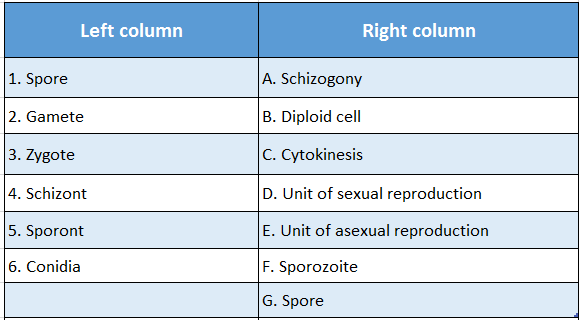
Answer: 1. E, 2. D, 3. B, 4. A, 5. F, 6. G
Question 2.
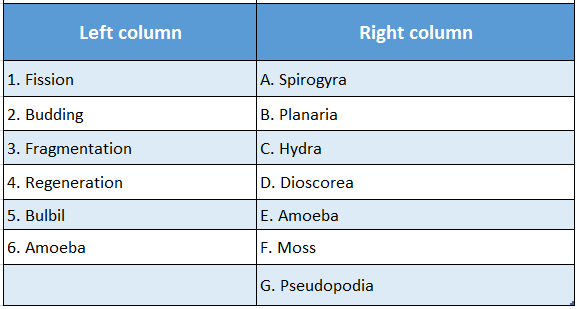
Answer: 1. E, 2. C, 3. A, 4. B, 5. D, 6. G
Question 3.
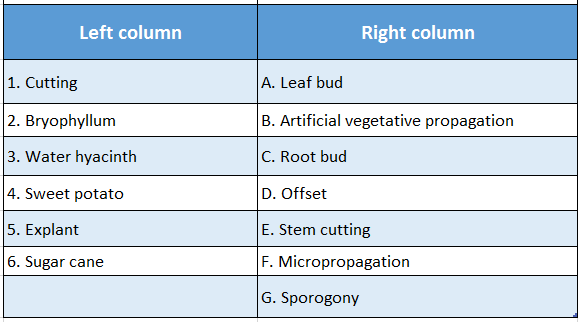
Answer: 1. B, 2. A, 3. D, 4. C, 5. F, 6. E
Chapter 2 Continuity Of Life Reproduction Find The Odd One Out
Question 1. Cutting of rose plant, Grafting of lemon plant, Micropropagation of carrot plant, Formation of leaf bud of Bryophyllum plant.
Answer: Formation of leaf bud of Bryophyllum plant.
Question 2. Schizogony of Plasmodium, Zoospore formation of Phytophthora, Conidiospore, formation of Penicillium, Budding of yeast.
Answer: Budding of yeast
Question 3. Oidia, Conidia, Zoospore, Gamete.
Answer: Gamete
Question 4. Zoospore, Aplanospore, Gamete, Embryo.
Answer: Embryo
Wbbse Class 10 Life Science Solutions
Question 5. Sponge, Hydra, Yeast, Sporulation
Answer: Sporulation
Question 6. Regeneration, Fragmentation, Budding, Syngamy.
Answer: Syngamy
Chapter 2 Continuity Of Life Reproduction Fill In The Blanks By Looking At The First Pair
Question 1. Leaf bud: Bryophyllum:: Adventitious root bud: ________.
Answer: Sweet potato
Question 2. Spirogyra: Fragmentation:: Yeast: ________.
Answer: Buddings
Question 3. Regeneration: Asexual reproduction:: Micropropagation: ________.
Answer: Vegetative reproduction
Question 4. Bryopyllum: Leaf bud :: Water hyacinth: ________.
Answer: Offset
Question 5. Binary fission: Amoeba:: Regeneration: ________.
Answer: Planaria
Wbbse Class 10 Life Science Solutions
Question 6. Grafting: Mango:: ________: Chinarose.
Answer: Cutting
Question 7. Heterogamete: Anisogamy:: Isogamete:: ________.
Answer: Anisogamy
Question 8. Motile spore: Zoospore :: Non motile spore: ________.
Answer: Aplanopore
Chapter 2 Continuity Of Life Reproduction Among The Four Concepts Given Three Of Them Belong To One Find That
Question 1. Adventitious root bud, Offset of water hyacinth, Natural vegetative propagation, Leaf bud of Bryophyllum.
Answer: Natural vegetative propagation
Question 2. Cutting of rose twigs, Grafting of lemon plant, Artificial vegetative propagation, Layering of Chrysanthemum branch.
Answer: Artificial vegetative propagation
Question 3. Asexual reproduction, Sporulation, Fragmentation, Budding.
Answer: Asexual reproduction
Question 4. Cutting, Grafting, Micropropagation, Artificial Asexual reproduction.
Answer: Artificial asexual reproduction
Question 5. Gametophyte, Sporopyte, Fertilization, Alternation of generation.
Answer: Alternation of generation
Question 6. Cutting, Grafting, Vegetative reproduction; Micropropagation.
Answer: Vegetative reproduction
Question 7. Spore, Conidia, Sporangiospore, Oidia
Answer: Spore
Question 8. Asexual propagation of animals, Schizogony of Plasmodium, Binary fission of Amoeba, Regeneration of Planaria.
Answer: Asexual propagation of animals
